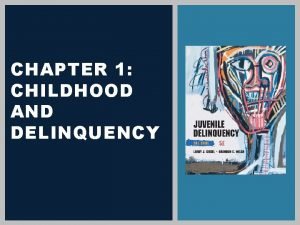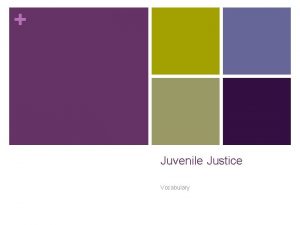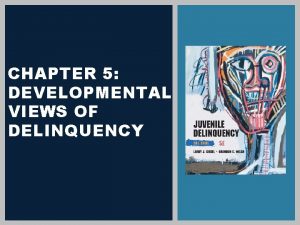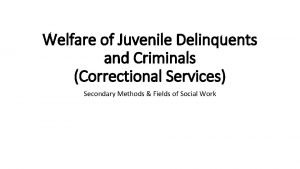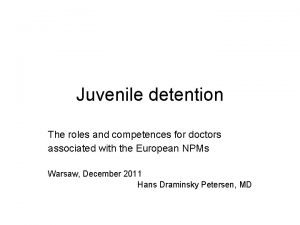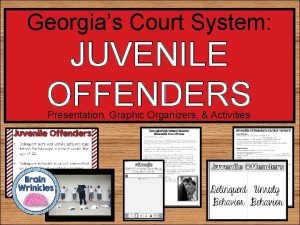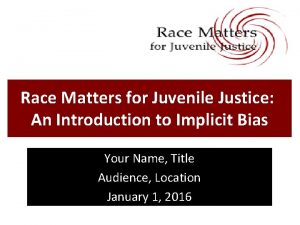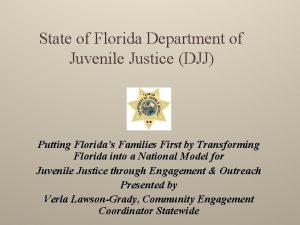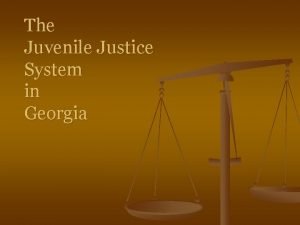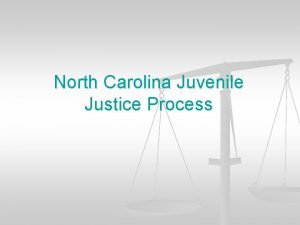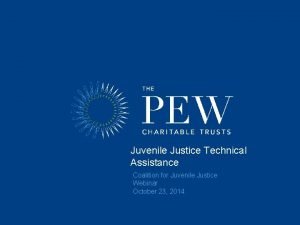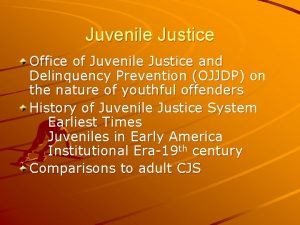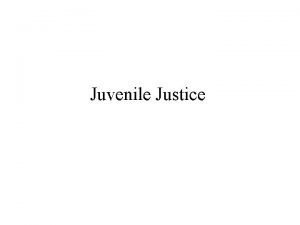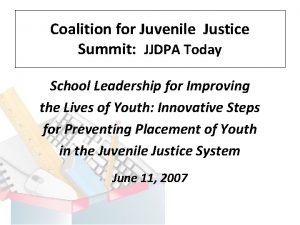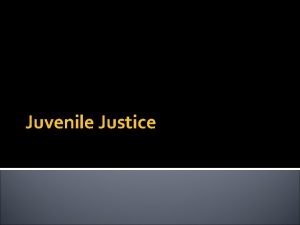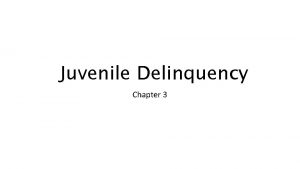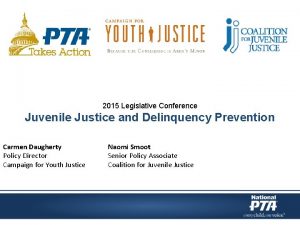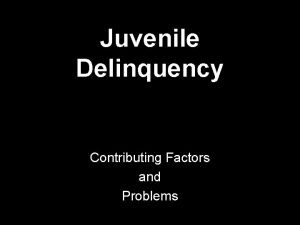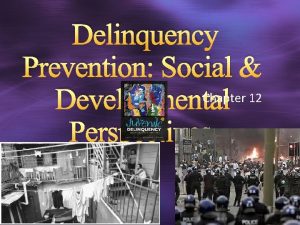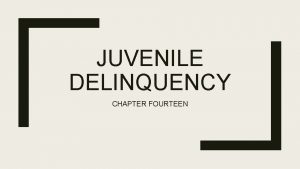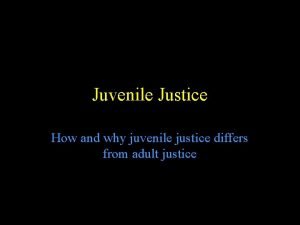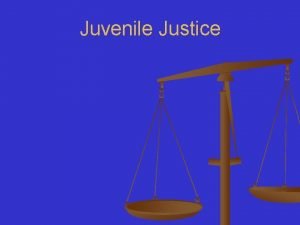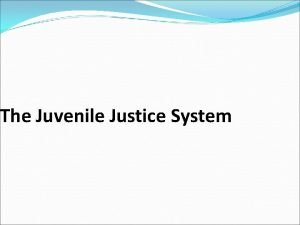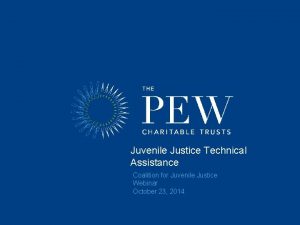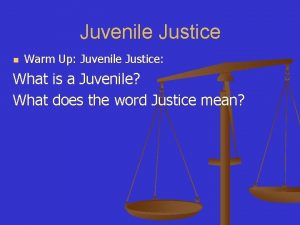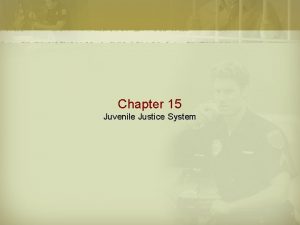The Juvenile Justice and Delinquency Prevention Act JJDPA























- Slides: 23

The Juvenile Justice and Delinquency Prevention Act (JJDPA) Youth Justice Leadership Institute July 25, 2011 Dana Shoenberg, Deputy Director Center for Children’s Law and Policy

JJDPA n n JJDPA authorizes federal funds to go to the states for juvenile justice In exchange, expectation that states comply with core requirements and write plans for delinquency prevention and intervention The U. S. Justice Department’s Office of Juvenile Justice and Delinquency Prevention (OJJDP) has reporting and technical assistance responsibilities Each state has an advisory group to guide plans and decide how to allocate funds

Guiding Principles of JJDPA n n Juveniles are different from adult offenders Juveniles are best served in age-appropriate facilities Status offenders should not be detained except in exceptional circumstances Youth of color should not be over-represented in the system © Richard Ross

Four Core Protections In Current Law n Jail Removal Juveniles should not be placed in adult jails n Applies pre and post-trial n n “Sight and Sound” Separation Applies to juveniles who are temporarily placed in adult jails n Must be separated from adult inmates by “sight and sound” n

Four Core Protections In Current Law, cont. n De-institutionalization of status offenders (DSO) n Status offenders cannot be locked up unless they violate a valid court order n Disproportionate Minority Contact (DMC) n States must “address” problem of overrepresentation

History of the Legislation n n First introduced in 1972 and passed in 1974, sponsored by Sen. Birch Bayh (D-IN). Bayh, who chaired the Subcommittee on Juvenile Delinquency, was concerned about trend toward incarceration which he saw as turning youth offenders into criminals. Among the influential witnesses at 1971 hearing was Lois Forer, author of 1970 book, “No One Will Lissen”: How Our Legal System Brutalizes the Youthful Poor. Using case studies, illustrated how juvenile justice practice and conditions in facilities encouraged hatred, violence, despair and wasted human possibilities. Bayh sought to create more prevention and rehabilitation opportunities.

History of the Legislation, cont. n n n The original requirements included: • Deinstitutionalization of Status Offenders (DSO) • Sight and Sound separation 1980 reauthorization added Jail Removal requirement and Valid Court Order Exception to DSO 1992 reauthorization added requirement to “address” Disproportionate Minority Confinement (changed to “Contact” in 2002)

History of the Legislation, cont. n n Reauthorized without serious changes since 1992; Last reauthorized in 2002 Last Congress: reauthorization bill in Senate, S. 678, introduced by Senators Leahy (D-VT), Specter (D-PA), Durbin (D-IL) and Kohl (DWI), eventually 14 more bipartisan cosponsors.

Risk to Youth in Adult Jails n Current law recognizes the risks youth face in adult jails n Sexual assault n n Suicide n n 13% of rape victims but <1% of prison population Youth 36 times more likely to commit suicide in adult facility than in a juvenile facility Lack of access to education n 40% of adult jails provide no educational services at all

Risk to Youth in Adult Jails, cont. n n n More than half of youth tried as adults are sent back to juvenile court or not convicted, but have spent at least 1 month in adult jail CDC and OJJDP reports - youth tried as adults are more likely to commit more crimes Conditions in adult jail amount to pre-trial punishment

Our goals for Reauthorization: n n Extend the jail removal protection to all youth, even youth charged as adults If any youth were to remain in jails, protect them by keeping them “sight and sound” separated from adults

Status Offenders in the JJDPA n n Status offenses: truancy, breaking curfew, disobeying parents, running away Current law: Status offenders may not be incarcerated, except that they can be detained under the valid court order (VCO) exception – i. e. a youth is truant, a judge issues a valid court order requiring the youth to attend school, the youth violates the judge’s orders and skips school

Problems with Detaining Status Offenders n n Detaining status offenders does not address the root of the problem- it often exacerbates problems Girls are disproportionately charged with status offenses and punished more severely than boys Community-based alternatives to detention are more effective and less costly © Richard Ross n

Our goals for Reauthorization: n Eliminate the VCO exception, encouraging states to use resources to develop alternatives to detention for status offenders and others

Current DMC Language n States must “address juvenile delinquency prevention efforts and system improvement efforts designed to reduce, without establishing or requiring numerical standards or quotas, the disproportionate number of juvenile members of minority groups who come into contact with the juvenile justice system. ”

Current State of DMC n Youth of color are: n n n Disproportionately represented in the juvenile justice system of every State. Disproportionately represented in all stages of the juvenile justice system… and the rates of overrepresentation increase as youth go through the system. More likely to be detained for low level offenses. More likely to receive out of home placements. More likely to be placed in adult jails.

Disproportionate Minority Contact: The Facts n African- American Youth n n 16% of adolescent population, but 38% of incarcerated youth Twice as likely to be detained in locked facilities away from home for drug offenses as white youth n Latino Youth n n n Incarcerated twice as frequently as white youth Sentences are twice as long for drug offenses as those of white youth 1. 5 times more likely to be sent to adult jail than white youth

Our goals for Reauthorization: n Provide greater guidance to states than just requiring that they “address” DMC - governing bodies to oversee reform, solutions informed by data analysis, tracking results and reporting them.

JJDPA and Related Funding n Title II State Formula Grants: supports state efforts to improve jj systems, n provide prevention and intervention services and n comply with the core protections; n state plan required n n Title V Local Delinquency Prevention Program: funds collaborative, community-based delinquency prevention, n prioritizes use of evidence-informed approaches, n requires state and local applicants to provide a 50% match n Coordination through state plan n

JJDPA and Related Funding, cont. Juvenile Accountability Block Grant (JABG): Originally for corrections, courts, prosecutors, etc. n now also supports graduated sanctions and mental health screening, substance abuse treatment, counseling, restitution, community service, gang prevention and more n © Richard Ross n

Federal Funding Crisis n n n Title II: 2011 $62. 3 million, down 30% since 2002. 2012 House bill would reduce to $40 million Title V: 2011 $54 million, but mostly for non-JJDPA programs, down 43% since 2002. Zero funded in 2012 House bill JABG: 2011 $45. 7 million, down 82% since 2002. Zero funded in 2012 House bill

Federal Funding: What to Do? n n n Watch closely in the next few weeks for talking points, call-in information and other resources from National Juvenile Justice and Delinquency Prevention Coalition regarding budget amendments Find local examples of programs that might lose funding if federal appropriations decline Contact your representative and others in your area to express concern about funding losses and support for budget amendments restoring funding

Contact and Resource Information Dana Shoenberg, Deputy Director Center for Children’s Law and Policy 202 -637 -0377, Ext. 107 dshoenberg@cclp. org www. cclp. org Act for JJ website: www. act 4 jj. org Coalition for JJ website: www. juvjustice. org Campaign for Youth Justice website: www. campaignforyouthjustice. org
 Ra.9344
Ra.9344 Primary prevention secondary prevention tertiary prevention
Primary prevention secondary prevention tertiary prevention Jjdpa
Jjdpa Nature of juvenile delinquency
Nature of juvenile delinquency Poverty and juvenile delinquency
Poverty and juvenile delinquency Juvenile justice act 2000
Juvenile justice act 2000 According to choice theorists, offenders
According to choice theorists, offenders Objectives of juvenile delinquency
Objectives of juvenile delinquency Juvenile justice vocabulary
Juvenile justice vocabulary Newspaper article on juvenile delinquency
Newspaper article on juvenile delinquency Developmental theory juvenile delinquency
Developmental theory juvenile delinquency Categories of delinquent youth
Categories of delinquent youth Causes of juvenile delinquency
Causes of juvenile delinquency Management of juvenile delinquency
Management of juvenile delinquency Juvenile delinquency graphic organizer
Juvenile delinquency graphic organizer Chapter 11 basic concepts street law
Chapter 11 basic concepts street law Race matters for juvenile justice
Race matters for juvenile justice State of florida department of juvenile justice
State of florida department of juvenile justice Juvenile justice alternative education program
Juvenile justice alternative education program Juvenile justice system georgia
Juvenile justice system georgia Undisciplined juvenile petition nc
Undisciplined juvenile petition nc Juvenile justice system in georgia
Juvenile justice system in georgia Coalition for juvenile justice
Coalition for juvenile justice Minnesota juvenile justice system
Minnesota juvenile justice system







